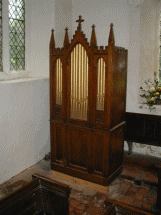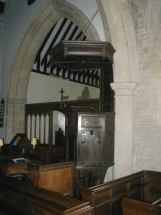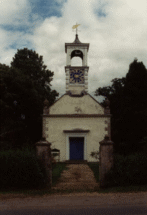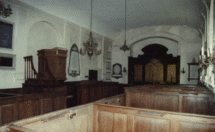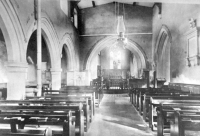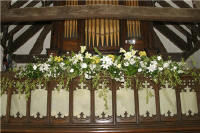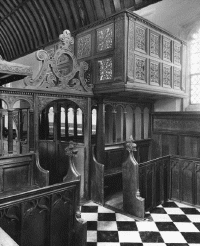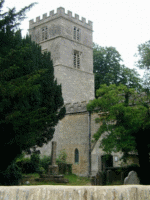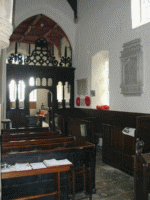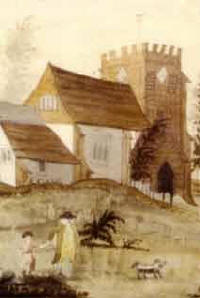|
|
|
You will then need to navigate back to this page using the County Index |
When looking at a modern map of Oxfordshire, please do remember that until the local government reorganisation of 1974 much of modern south-west Oxfordshire was in Berkshire. The river Thames (or Isis) which runs through Oxford, defined the southern boundary of the county until 1974 (as shown in the nearby image). Prior to that date towns such as Shrivenham, Faringdon, Wantage, Abingdon, Didcot and Wallingford (to name but a few) were in Berkshire as, indeed, was a considerable piece of what is now the south-west corner of the City of Oxford.
Because of significant boundary changes between Oxford and adjoining counties, certain places may not be found where you think they should be. In which case, please use the following links:
|
Churches which still retain west gallery features or connections |
|||||||||||
| Berrick Salome, St Helen | SU623943 Originally Norman, or late Saxon, the church was rebuilt and added to in the 13th C, and the roof timbers date from 1615. The fittings were all of the 17th C., although the box-pews have been cut down, and the three-decker pulpit removed. Apart from that, the west gallery remains, together with a multitude of exposed beams. The inscription, picked out in gold leaf, on the front of the gallery states: | ||||||||||
|
|||||||||||
| A little known gem which has escaped many of the guide books. # | |||||||||||
| Bessels Leigh, St Lawrence | See Berkshire | ||||||||||
| Brightwell Baldwin, St Bartholomew |
SU653950.
The
church is set above the road on a bank, and contains a brief history of the
development of the music which was used in this church. There is a box-pew for
the quire, complete with central music stand, barrel organ,
American organ in the chancel,
and modern organ at the west end. The pulpit with its tester is Jacobean.
|
||||||||||
| Buckland, St Mary the Virgin | SU343983 Jacobean gallery above the old rood screen, accessed by separate stair from outside south side of church | ||||||||||
| Burford Chapel, Dedication not known | The west gallery is dated 1662. Restored 1937 by W H Godfrey. The gallery supported on two twisted columns, their capitals carved with eagles. | ||||||||||
| Chiselhampton, St Katherine |
On the
edge of a small park, and almost within a farmyard, stands this little white
painted church, of classic design, bell-cote with weather-vane, and clear glass
to the round-headed windows. Inside are box-pews, a two-decker pulpit with
adjoining clerk's desk, wooden altar, candles and tablets - all making a
classic Georgian interior. Harmonium now in box-pew by pulpit.
|
||||||||||
| *Cumnor, St Michael |
12th C. church, and later, with
two-decker pulpit and clerk's desk, early Bible.
photos from: http://www.bodley.ox.ac.uk/external/cumnor/photos-places.ht |
||||||||||
| Easington, St Peter | A small church in an isolated farmyard, unspoiled and with a Jacobean pulpit, harmonium and candles. | ||||||||||
| Hampton Gay, St Giles | Recorded in Norman times, the church was rebuilt during the period 1767 -72. The pulpit and box-pews were removed by the local curate in 1859, and the remaining Georgian features are the west gallery, the coved and panelled ceiling, the stone ball finial on the roof, and the weather vane. There is a working barrel organ on the gallery. | ||||||||||
| Little Coxwell, St Mary |
The church is believed to contain a
west gallery, details unknown, but
believed to be used for the organ.
The carved wooden rail of the gallery used to be part of the
pre-Reformation rood screen. Iron
Hour-Glass stand.
picture from: http://www.achurchnearyou.com/image.php?id=10390 |
||||||||||
| Northmoor, St Denys | The west gallery is dated 1693. | ||||||||||
|
Marsh
Baldon, St Peter
also Toot Baldon, St Lawrence |
The church is included because of its known association with west gallery music and the Marsh Baldon MS. | ||||||||||
| Oxford, St Mary the Virgin | SP516062 The Parish and University Church, and the only church in Oxford itself to have a west gallery. | ||||||||||
| Rycote Chapel, St Michael and All Angels |
Set in a park and near a lake, this is a remote
15th C. domestic chapel , with nave and chancel. Its fittings are no later than
Laudian times, with 15th C. benches, and base of screen, early 17th C.
two-storeyed Royal pew, with a blue ceiling and golden stars, a domed family
pew, late 17th C. altar-piece and Communion rails, and clear old glass in the
windows. Queen Elizabeth I and Charles I both worshipped here when on visits.
Now owned by the National Trust.
picture from:
http://www.architecture.com/HowWeBuiltBritain/HistoricalPeriods/ |
||||||||||
| Shorthampton, All Saints | Situated in a tiny and remote hamlet between Burford and Charlbury, this is a small rectangular building, aisle-less and with a bell-cote on its western end. It dates from Norman to 18th C. times; then in 1820 it was furnished in a carpenter's style with box-pews and high pulpit (just a two-decker!). At the same time the chancel was rebuilt, looking out over unspoilt farmland, and with clear glass in its eastern window. | ||||||||||
| South Leigh, St James | SP394090 Wall paintings. Here John Wesley preached his first sermon. | ||||||||||
| *Steeple Aston, dedication not known | The church contains a west gallery surmounted by a modern organ. | ||||||||||
| *Waterperry, St Mary the Virgin |
Waterperry is a remote village, and the small
church stands close by the old Manor House, and now within a stone's throw of a
Garden centre, the old park now being open to the public. Originally mediaeval,
the interior was classicised in 1750, and contains hatchments, tombs of the
local family, two-decker pulpit, old pews, clear glass in the windows, and a
classic altar with Communion-rails.
|
||||||||||
| Wheatfield, St Andrew | In the middle of parkland, this is a small rectangular church et on the slope of a hillside and some yards away from the old private drive to Wheatfield House, itself demolished in 1814. Box-pews, round-headed windows with clear glass, and a two (or three?) decker pulpit. Currently used as a store house. | ||||||||||
| Yarnton, St Bartholomew |
Originally a 13th C. church, to which was added
in 1611 an ashlar tower, porch an a chapel by Sir Thomas Spencer, all late
Perpendicular style. Fittings include old pews, some of the old box-pews having
been preserved, early Bibles and Prayer Books.
|
||||||||||
|
Churches which are known to have had west gallery features or connections |
|||||||||||
| Alvescot, St Peter | SP273046 Family pews were noted also in the south transept, and a west gallery mentioned in 1866 was perhaps of 17th-century origin. No longer there. | ||||||||||
| Bicester, St John the Baptist | Various galleries added between mid 17th C. and 19th C., "appropriated to the use of private owners". Removed 1862. | ||||||||||
| Black Bourton, St Mary the Virgin | SP286043 | ||||||||||
| Bletchingdon, St Giles | SP506180 | ||||||||||
| Burford, St John the Baptist | Set at the bottom of the High Street adjoining the River Windrush, the church now appears largely 15th C. inside, although altered and added to at various times. There is a model in the church showing the original box-pews, side galleries and pulpit before the usual drastic Victorian "restoration". | ||||||||||
| Chesterton, St Mary | SP317455 | ||||||||||
| Clanfield, St Stephen the Martyr | SP283022 | ||||||||||
| Cumnor, St Michael | See above. | ||||||||||
| Launton, St Mary the Virgin | SP604228 | ||||||||||
| Mapledurham, St Margaret |
SU670766.
picture from: http://www.mapledurham.co.uk/history/church/ |
||||||||||
| Steeple Aston, Dedication not known | |||||||||||
| Stratton Audley, Dedication not known | |||||||||||
| Sotwell, St James | Used to contain a two-decker pulpit and a west gallery, removed in 1884 when the church was rebuilt to prevent collapse. A fiddle, a flute and an accordian were remembered by an old parishioner as having accompanied the quire. | ||||||||||
| Thame, St Mary the Virgin | Galleries, including singing gallery, removed in 19th C. In 1908 choir stalls were constructed which incorporated the front of the Jacobean gallery which was removed from south aisle. | ||||||||||
| Warborough, St Lawrence | "In 1638 a west gallery was erected and the dormers inserted to light it." (Churches of the Thames Valley). Implies gallery no longer there. (no ref. in Pevsner.) | ||||||||||
| Wendlebury, Dedication not known | |||||||||||
|
Chapels which have or had west gallery features or connections |
|||||||||||
| Alvescot, Strict Baptist | SP 271046. Built early 19th Century for church formed in 1833. Rear gallery with original open-backed pews, other seating replaced. (C&MH-N&O 1986) | ||||||||||
| Cote Chapel, nr. Aston Bampton and Shifford, Baptist |
SP 351031. Built
1703-04, capacity increased in 1756 by the addition of a
gallery. Drastic alterations in 1859, in which the pulpit
was removed to the west wall from the South, the galleries
were altered or rebuilt against the other three walls and
the seating renewed. The galleries are around three sides,
with staircases in the NE and SE corners. The seating is
entirely of 1859 vintage with box-pews and a central table-pew
above the baptistry. Round-headed clear glass windows. (C&MH-N&O
1986)
See the Historic Chapels Trust web site at http://www.hct.org.uk/chapel1cote.html, to whom we are indebted for part of this information. |
||||||||||
| Bampton, Baptist | SP 316032. Certificate dating from 1778 probably refers to the building of this chapel. East gallery with panelled front and original seating. Lower pews reported to have been renewed/replaced in 1981, and the late 18th cent. pulpit at the west end has been lowered. (C&MH-N&O 1986) | ||||||||||
| Banbury, Friends, Horsefair | SP 454406 Site was acquired in 1664 and the chapel built the following year. Largely rebuilt in 1748-51 although some parts of walls remain. (C&MH-N&O 1986) | ||||||||||
| Bicester, Congregational, Chapel Street | SP 585223 The congregation, originally Presbyterian, was gathered after 1662 by John Troughton, fellow of St John's College, Oxfprd. The present building probably dates from 11111728, when it was then described as being in Water Lane, adjoining the Swan. The west front was much altered to it present form in 1873. The interior, also reconstructed, now has a rostrum pulpit at te South end, and a single gallery opposite, supported on two turned wood columns of the 18th century. Compare also Buckingham, Old Meeting-house.(C&MH-N&O 1986) | ||||||||||
| Burford with Upton and Signet, Baptist, Witney Street, Burford | SP 254121. The congregation, founded ca. 1700, built this chapel in 1804 on the site of its predecessor. The interior, much altered in 1886 and later, has a rear gallery with front incorporating re-used fielded panels. (C&MH-N&O 1986) | ||||||||||
| Burford with Upton and Signet, Friends, Pytts Lane, Burford | SP 252121. Built in 1709 to replace the one at Barrington, it was closed in 1854, reopened for twenty years at the beginning of the twentieth century, and again reopened in 1955. The interior has a gallery along the south and west sides, with signs of enlargement (C&MH-N&O 1986)(C&MH-N&O 1986) | ||||||||||
| Chinnor, Congregational | SP 756013. Built 1805, considerably enlarged in 1811, altered again in the late 19th century, which included re-roofing and the removal of the old pews. The interior, which is nearly square, has a gallery of ca. 1811 around three sides with a blind balustraded front ornamented at the corners by flat obelisks. Some early 19th century benches with shaped ends remain at the back of the NW and SW galleries. (C&MH-N&O 1986) | ||||||||||
| Cote, Baptist Chapel | The site of Cote Chapel was acquired in 1703-4 by a group of worshippers which previously met at Longworth on the other side of the Thames. In 1739-40 the Chapel was enlarged or more probably rebuilt to its present size, the capacity being increased in 1756 by the addition of a gallery, which seems to have been built by Stennett. In the late 1859 all but the outer shell was rebuilt: the earlier double gable was replaced by a single flat-topped gable concealing the roof valley, the chapel was re-floored and the vestries enlarged, new pews, (including a table pew over the central baptistry) were installed and new galleries added. (VCH and Historic Chapels Trust web site.) | ||||||||||
| Deddington, Wesleyan Reform, Chapel Square | SP 468316. Brick and slate with square ended front, central round-arched doorway between pair of two-light windows and wider window of three lights above. Tablet over entrance dated 1851 and a gallery inside of this period, but otherwise largely refitted in the late 19th century. (C&MH-N&O 1986) | ||||||||||
| Goring, Countess of Huntingdon's Connexion | SU 599807. An Independent church was formed in 1786, the members subscribing to a Confession of Faith 64 pages in length and divided into 33 chapters. the first meeting house on the present site was built in 1793 and opened by Lady Anne Erskine. It was superseded in 1893 but survives in altered form as a Sunday School. This has walls of brick with some flint at the sides and a hipped and tiled roof with a central flat or valley. The north front is of three bays with two tiers of windows and a central arched entrance with late 19th century dressings. The south wall has two original round-arched windows flanking the site of the pulpit. The interior has a gallery around three sides divided by fluted pillars and supported by square wooden posts; some original seating remains in the gallery. (C&MH-N&O 1986) | ||||||||||
| Hook Norton, Baptist, High Street |
SP 354331. The chapel,
built in 1787, replaces an earlier chapel on 1718. It has
walls of ironstone and a hipped roof now recovered with
tiles. Two round-arched windows in the north wall with later
cast-iron intersecting glazing bars are repeated on the
south and east sides. The entrance is at the west end in a
two-stories porch which incorporates the gallery staircase;
there are four small windows at two levels in the west
wall.
The interior has an original west gallery with fielded panelled front, and later galleries added along the north and south walls. The box-pews and pulpit, which date from the refitting of 1856, have stop-chamfered panelled sides. (C&MH-N&O 1986) |
||||||||||
| Hook Norton, Friends, Southrop | SP 357328. Demolished in 1950, the meeting-house built in 1704 stood south-east of Southrop Hall. As a small chapel (28ft x 16ft) it had a stand at the south-west end and a small gallery opposite. A rubble boundary wall remains around the site. (C&MH-N&O 1986) | ||||||||||
| Milton-under-Wychwood, Baptist | SP 263180. A chapel opened in 1808 was reported in 1839 to be in a dangerous state. It was replaced in the same year by the present building at a reported cost of £372. 9s. 6½d. It has a rear gallery, but the pews were renewed in the late 19th century. (C&MH-N&O 1986) | ||||||||||
| Mollington, Former Primitive Methodist | SP 440474. Built 1845 and refronted ca. 1860, it was closed in 1947 and subsequently used by Brethren and is now in secular occupation. Part of the structure of a south gallery remains. (C&MH-N&O 1986) | ||||||||||
| Oxford, Baptist, New Road | SP 512062. A Baptist church was in existence by 1656 in which year it sent messengers to the Abingdon Association. The cause fell into decay in the early 18th century and when, in 1715, the Baptist and Presbyterian meeting-houses were severely damaged by rioters, the two societies united and built a new meeting-house in new Road, ca. 1731. The present chapel dates from 1798, of which only parts of the side walls remain. In 1819 the chapel was enlarged to the south and the present front built. There are galleries on three sides, but these may only date from the refitting of 1896, or the complete refurbishment in 1980. (C&MH-N&O 1986) | ||||||||||
| Rotherfield Peppard, Congregational | SU 708809. The chapel, now concealed by the manse and later buildings to the east and west, was opened in 1796, and paid for by Peter French, one of the trustees of the Castle Street Chapel, Reading. The interior has a gallery at the south end. (C&MH-N&O 1986) | ||||||||||
| Shutford, Former Friends | SP 386404. Built as a meeting-house in the late 17th century and converted into a cottage ca. 1840. Of three bays, the eastermost still has an original staircase with flat balusters and newel with ball finial which gave access to a gallery of which the plain slatted balustraded front remains in an upper partition. A similar gallery appears to have existed at the west end, and the area between was floored over in the 19th century. (C&MH-N&O 1986) | ||||||||||
| South Newington, Former Friends | SP 407331. The meeting-house was built in 1692, and is now used as the Village Hall. A small dormer window near the west end lights one end of the galley, this probably being inserted in the later 18th century. There is a fireplace below in the north-west corner. (C&MH-N&O 1986) | ||||||||||
| South Stoke, Independent | SU 599834. The chapel, built in 1820 in association with the Countess fo Huntingdon's congregation at Goring, has brick walls and a hipped tiled rof. Entrance at east end with gallery window over, and two windows on south side. (C&MH-N&O 1986) | ||||||||||
| Watlington, Wesleyan | SU 691945. Dated 1812. West front in Flemish Bond brickwork, with glazed headers and cast-iron gable ornaments. Original gallery around three sides, seating later. (C&MH-N&O 1986) | ||||||||||
| West Adderbury, Former Friends | SP 465354. The meeting-house, now a store for the adjacent public cemetery, was built in 1675. Walls of coursed rubble and the roof, now tiled, was formerly slated in stone. The interior has deep galleries with plain balustraded fronts around east, south and west sides, possibly the extension of a gallery or upper room at the west end only . . . The stand against the north wall dates from the 18th century. (C&MH-N&O 1986) | ||||||||||
| Wheatley, Brethren | SP 594058. An early 19th century granary with rubble walls lined in brickwork and gabled ends with shaped kneelers. Converted by partial removal of upper floor, leaving a gallery at one end. (C&MH-N&O 1986) | ||||||||||
| Witney, Former Congregational, High Street | SP 355098. Built in 1828 at the expense of William Townsend of Holborn. Walls of squared stone, the east being of ashlar blocks; the principal windows, of two lights with uncusped tracery, are set in projecting panels surmounted by false parapets. Above the entrance is a circular window with quatrefoil tracery. The interior has a flat plastered ceiling with moulded cornice, central plaster ceiling-rose and four ventilating grilles with Gothic tracery. A gallery at the east end has a panelled front supported by cast-iron columns. Organ mid-19th century. Demolished 1970-72 to make way for Waitrose supermarket. (C&MH-N&O 1986) | ||||||||||
| Witney, Former Friends | SP 360104. A meeting-house of 1676 was replaced in 1712 by the present building, which was in use as a hall in 1969 and appears to have been converted to residential use by about 1980. There was a gallery at the north end, which seems to have been accessed through two openings in the wall at first floor level from the adjacent building where there was also a stair. (C&MH-N&O 1986) | ||||||||||
| Wroxton, Former Wesleyan | SP 413418. Behind 'Sundial Farmhouse', Wroxton. Built ca. 1820, with walls of squared stone and a slate roof. Two windows in west front with entrance near south end replaced by garage doors. Site of pulpit at north end with painted inscription on wall and traces of gallery opposite. Present chapel is 250 yards west, dated 1935. (C&MH-N&O 1986) | ||||||||||
| Asterisks denote churches in preparation | |||||||||||
|
|
